The spider plant is a beloved species that never seems to go out of style. The spider plant is a hardy and charming plant native to coastal areas in South Africa. It gets its name from its gently arching, strap-shaped foliage in colors of solid green or variegated white or yellow lengthwise stripes. Unfortunately, some spider plants tend to become leggy and less “bushy” in incorrect environments.
Making a spider plant bushier requires meeting all of its care needs, including sun, temperature, humidity, water, and soil requirements. In addition, pruning and repotting the plant will maximize the plant’s bushiness. Lastly, use a couple of spiderettes to fill to create a bushy appearance.
Just for your information, the “spiderettes” are spider plant babies.
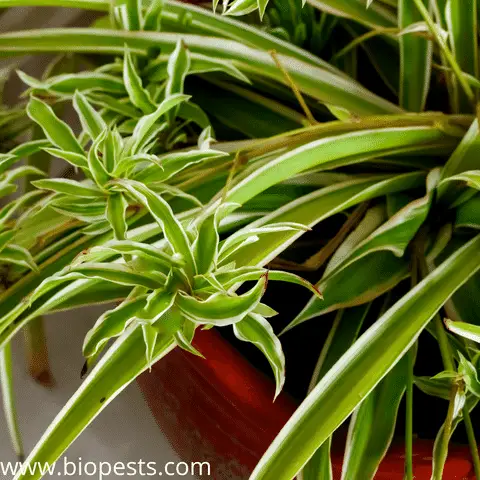
Despite the spider plant’s ability to survive in less-than-perfect environments, mimicking its native tropical climate will ensure that it grows into a bushy, healthy plant.
How To Get A Spider Plant Bushier?
Even though the spider plant tolerates poor conditions, the better you meet its needs and preferences, the healthier and bushier the spider plant will be.
You’ll need to meet several essential requirements for the spider plant to shoot out bushy mounds of drooping foliage. Fortunately, this plant is relatively easy to care for, making these conditions attainable for everyone, including novice plant owners.
A quick cheat but highly effective method is to fill in the spider plant with several spiderettes that your prune off the mother plant; this will allow a fuller, bushy appearance in no time.
Anyway, let’s dive into the primary care requirements that will ensure a bushier spider plant.
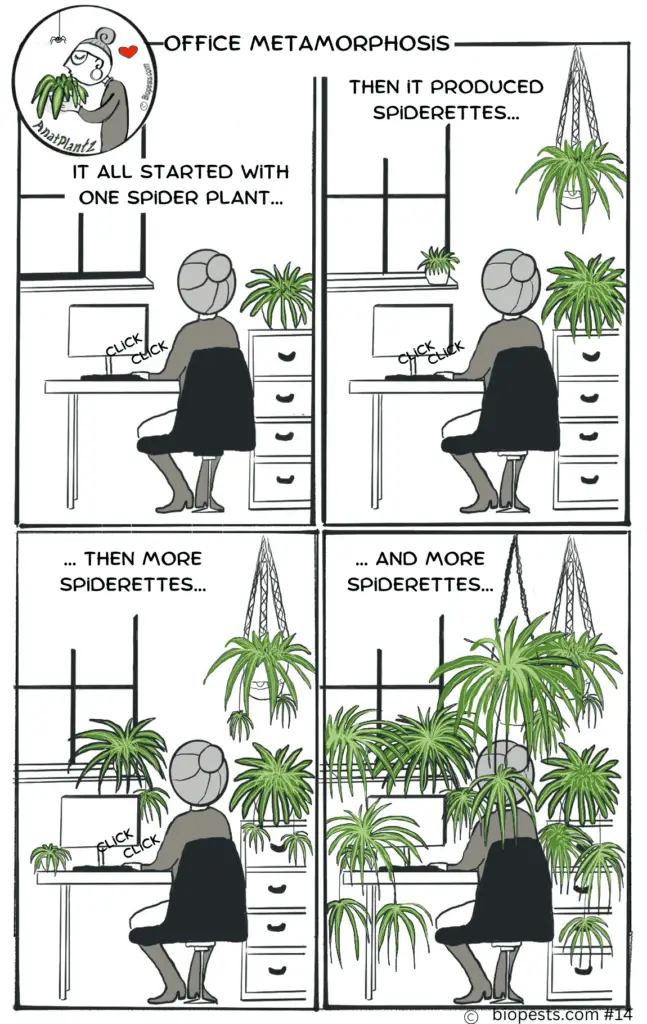
Comics by AnatPlantz
1. Ensure Appropriate Light Requirements For A Spider Plant
Spider plants grown outdoors prefer to grow in lightly shaded areas. Although they can tolerate full shade, their growth won’t be as robust to give you the bushy effect you’re after, whereas direct sunlight is too harsh and will scorch the delicate foliage.
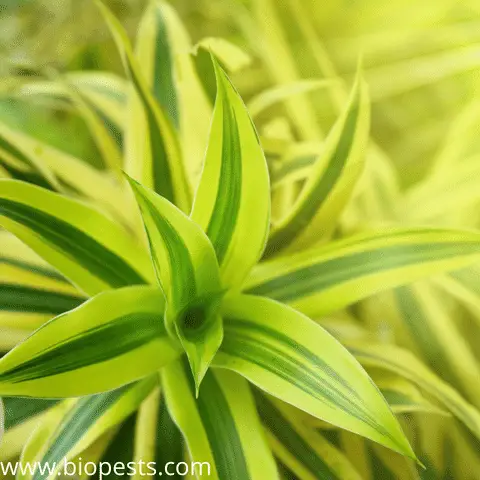
On the contrary, spider plants are easy to grow indoors; ideally, place them in medium to bright light year-round. A bright, east-facing window that provides four to six hours of sun is perfect for encouraging the spider plant to produce bushier foliage.
2. Temperature Requirements For A Spider Plant
Spider plants are generally fans of moderate temperatures around 65 to 75°F during the day and slightly cooler temperatures of 55°F at night.
In addition, spider plants do not tolerate icy temperatures below 50°F or warm conditions above 80°F.
If you keep your spider plant indoors, try to stay within a similar range to ensure the plant thrives. You can consider placing the potted plant outside during the spring and early summer months while temperatures aren’t too hot or too cold.
Also, be sure to protect the spider plant from drafts, heaters, and air-conditioning vents as these conditions stress the plant and cause it to become less bushy.
3. Ensure Appropriate Humidity Requirements For A Spider Plant
Native to humid climates, spider plants prefer moderate to high humid climates. The ideal humidity level is generally 60% or more.
Although the spider plant is hardy and versatile enough to survive humidity levels as low as 40%, it yields better growth in humidity levels ranging between 60 and 80%.
There are several options to consider to increase the humidity for the spider plant.
- Misting the plant: Mist the spider plant occasionally to maintain adequate moisture levels.
- Use a humidifier: Adding a humidifier to the room your spider plant is in will go a pretty long way in helping to keep the desired humidity level for your spider plant to thrive.
- The Pebble-water Tray Method: Another alternative would be to place your spider plant atop a watered pebble tray. Keep the water level below the upper surface of the pebbles.
- Group planting: Grouping spider plants with other tropical plants is a common practice to increase the humidity level.
- Add an aquarium: Believe it or not, if you place a small aquarium in the same room as the spider plant to naturally raise the humidity. You’ll not only have a beautiful exotic piece to boost the moisture. In addition, you can use the water to fertilize the spider plant occasionally, further improving the chances of a bush spider plant.
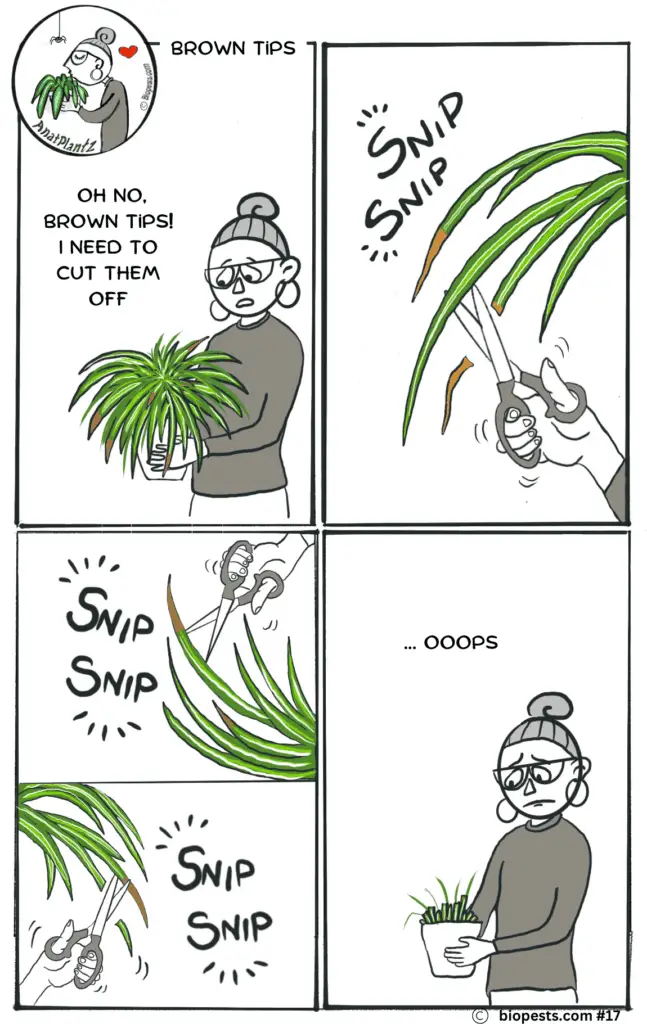
Comics by AnatPlantz
4. Ensure Appropriate Soil Requirements For A Spider Plant
We all know that the appropriate soil is a crucial element for plant growth; it allows the plants to access nutrients, water, and oxygen to grow and thrive. Likewise, spider plants need healthy, supporting soil to encourage bushier plants.
The spider plant enjoys moist yet well-draining soil. Therefore, compact soil types may stress the plant, making it difficult to grow. A couple of indicators will show you that your spider plant is unhappy with its soil.
Here are the common indications to keep an eye out for:
- Foliage dropping or falling off the spider plant.
- Discolored leaves, including yellow, brown, and black.
- Brownish spots on the leaves.
- Root rot at the base of the spider plant.
As you can see, compact soil can easily cause root rot from the soil being unable to drain correctly. Therefore, steer clear of dense soil like gardening soil.
Instead, consider using organic potting soil, and for bushy, thriving plants, try adding perlite and pumice to ensure adequate draining.
In addition, spider plants tolerate slightly acidic to slightly alkaline soil. However, they prefer soil with a neutral pH. So, ideally, provide a pH ranging between 6 and 7.2.
My recommendations for the best soil are the following (available on Amazon)
Burpee Premium Organic Potting Soil
Miracle-Gro Houseplant Potting Mix
If you’d like to prepare the perfect soil mixture for spider plants, use a mixture of well-draining, organic potting soil, orchid bark, either charcoal, perlite, or pumice, and compost.
Lastly, spider plants do not like high salt concentrations as it causes the leaf tips to turn brown. Therefore, use appropriate fertilizer amounts and water the plant using distilled or rainwater to prevent or at least minimize salt accumulation in the soil.
Tip: replace the soil every year or so to improve the chances of a bushy spider plant.
5. Ensure Appropriate Water Requirements For A Spider Plant
Every spider plant’s watering needs will differ based on the sun, humidity, and temperature it has been exposed to; however, there is a good rule of thumb to follow when unsure.
Water the spider plant when the top two inches of soil dry out. The spider plant is susceptible to overwatering; overwatering can harm the plant. So, it’s best to wait a day or two when in doubt.
If you mistakenly overwater the spider plant, you’ll notice that the leaves start to turn yellow and drop (if excessive). Consider changing the watering frequency to ensure your snake plant is healthy.
In addition, the spider plant is pretty sensitive to high salt, chlorine, and fluoride, generally found in tap water. So, if possible, water the spider plant with rainwater or distilled water for container plants.
If you are having issues with overwatering or soil not drying as fast as you wish, check out my tips on how to dry houseplant soil faster.
6. Ensure Appropriate Fertilizer Requirements For A Spider Plant
Spider plants are incredibly durable plants that can easily survive without fertilizer. However, if you’re looking for a lush, bushy spider plant, occasional fertilizer during the growing season can help revitalize the plant from its winter slumber.
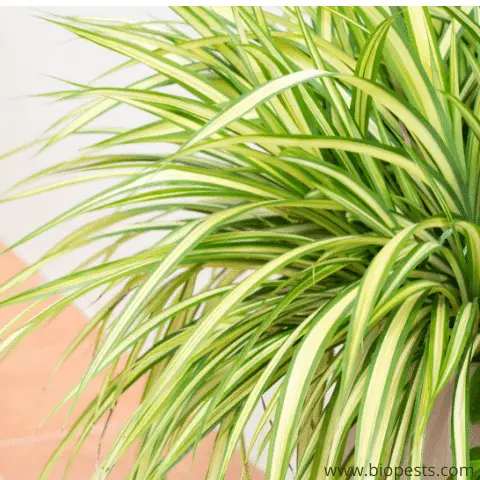
Fertilizer will encourage foliage growth and noticeably produce a bushier spider plant. However, note that the spider plant is generally dormant during the fall and winter. So, it’s best to only supply fertilizer during the growing season (spring and summer).
You can either use organic or inorganic fertilizers to feed the spider plant; however, organic fertilizer is better.
A product I really like is Biochar. This is a game-changer. It works wonders in all soil types, delivering more nutrients to your plants while requiring less work on your part. Not only does it create healthy soil, but it also contributes to a better world. You remove two pounds of CO2 from the atmosphere for every pound of biochar you use.
Organic fertilizer ensures that natural nutrients are added to the soil and prevents exposure to foreign chemicals and residues in the spider plant’s soil. In addition, organic fertilizer is generally slow-releasing and prevents fertilizer burns.
Nevertheless, inorganic fertilizers, including pellet and liquid fertilizers, can promote a bushier spider plant. However, using inorganic fertilizer for extended periods can create salt residues harmful to spider plants, making the plants more susceptible to pests.
If salt residues start forming on the sides or the bottom of the pot, it’s best to replace the soil to prevent harming the spider plant.
How Much Fertilizer Does A Spider Plant Need?
The amount and frequency that a spider plant needs fertilizing will depend on its maturity and how often you replace its soil.
Spiderettes are tender and tend to burn when you overexpose them to fertilizer, whereas excess fertilizer can cause brown leaf tips on older plants.
As a general rule, fertilize mature spider plants every two to four weeks with a half-strength, all-purpose fertilizer during the growing season. In addition, avoid fertilizing during its dormant phase during the fall and winter.
7. Pruning A Spider Plant Makes It Bushier
Pruning a spider plant is suitable for your plant for various reasons. It helps keep diseases and pests away, allows your plant to retain a preferable shape and size, and promotes bushier growth as it rejuvenates the overall vigor and health of the spider plant.
You’ll require nothing more than a good, sterilized pair of scissors or gardening shears. Spider plants will primarily benefit from a trim during spring and summer to encourage new growth.
Lightly trim your spider plant by plucking away yellow and dead leaves; this will also help prevent unwelcome pests from settling on your spider plant. In addition, cut away brown leaf tips to ensure the plant looks healthy.
8. Repotting The Spider Plant Can Make It Bushier
Yes, repotting a spider plant can also help to make it bushy. Unfortunately, spider plants tend to outgrow their pots faster than most other houseplants. The overgrown tuberous can even crack the container in some severe cases.
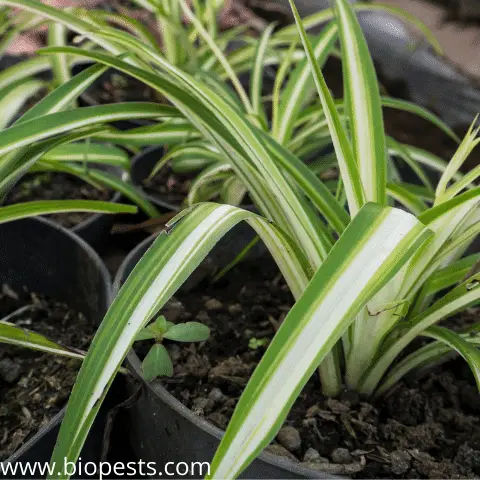
Although spider plants grow best when slightly rootbound, they require repotting as soon as the roots start showing above the soil. Thus, spider plants generally need repotting every one to two years.
Fortunately, repotting a spider plant is a relatively easy task. Start by gently removing the spider plant from its current container, rinsing and trimming any mushy roots, then replanting the spider plant into a larger pot.
Ensure that the new, larger pot has appropriate drainage holes, and use a soilless medium or all-purpose potting soil for spider plant repotting.
You’ll want to fill the bottom of the container with the potting mix, then place the spider plant’s roots into the soil. Keep adding the potting soil to the pot while gently tucking it around the plant’s roots. Once the container is full, water the spider plant well and care as usual.
A pot perfect in size with fresh potting soil will guarantee a happier and bushier spider plant!
9. Propagating A Spider Plant Will Make It Bushier
Spider plants are super easy to propagate. You’ll want to leave the newly growing plantlets (spiderettes) on the mother plant until the roots of the baby plant grow to at least one or two inches long.
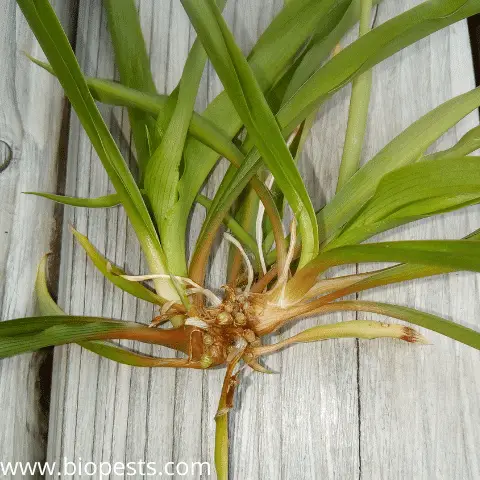
Once the roots of the spiderettes develop, carefully cut the plantlets off the stem using a clean pair of pruning shears or scissors, ensuring the roots are still intact. Then, root the spiderettes into water or soil. Lastly, put them into a container with ample drainage and ensure the soil stays moist until the new plants establish.
Alternatively, dig up mature spider plants and divide them by gently pulling the root ball apart into sections, damaging the roots as little as possible. Then, replant the divisions.
You can add the spiderettes into the same pot as the mother plant to create a fuller, bushier appearance. In addition, dividing the mother plant into separate spider plants will contribute to a lush, bushier spider plant later on; however, they need a bit of time to recover from the stress of propagating.
Tips for Dealing with Brown Tips
One common issue that spider plant owners may encounter is the dreaded brown tips on the leaves. If you’ve noticed this problem with your spider plant, don’t worry! Here we will provide you with some helpful tips on how to revive your plant and prevent further damage.
- Understanding the Causes of Brown Tips:
Brown tips on spider plants can be caused by a variety of factors, including overwatering, underwatering, low humidity levels, direct sunlight exposure, or even the use of tap water that contains high levels of fluoride or chlorine. To determine the cause of the brown tips on your spider plant, take a closer look at its environment and watering routine. Make adjustments as needed to address any potential issues.
- Adjusting Watering Habits:
One of the most common reasons for brown tips on spider plants is improper watering. Spider plants prefer consistently moist soil but can suffer if they are either overwatered or underwatered. To prevent brown tips from occurring due to watering issues, water your spider plant thoroughly when the top inch of soil feels dry to the touch. Ensure that excess water can drain freely from the bottom of the pot to avoid waterlogged roots.
- Providing Adequate Humidity:
Spider plants thrive in environments with moderate to high humidity levels. If your home has low humidity, especially during winter months when indoor heating can dry out the air, consider increasing humidity around your spider plant by misting its leaves regularly or placing a humidifier nearby. This simple step can help prevent brown tips caused by dry air.
- Choosing the Right Lighting Conditions:
While spider plants enjoy bright, indirect light, they do not fare well in direct sunlight exposure. Too much sun can scorch their delicate leaves and lead to unsightly brown tips. Place your spider plant in a location where it receives filtered sunlight or indirect light throughout the day to ensure optimal growth without risking sun damage.
- Trimming Dead Leaves and Tips:
If your spider plant already has brown tips on its leaves, don’t fret! You can easily trim off these damaged sections using clean scissors or pruning shears. Make sure to cut at an angle just below the brown tip without damaging healthy tissue. Regularly removing dead or dying leaves will not only improve the appearance of your plant but also promote new growth.
What Are The Best Companion Plants For Spider Plants?
The spider plant is an excellent filler. If you want to create an impressive centerpiece or composition of plants, you can mix your spider plant with Pothos and Philodendrons. They make excellent companion plants and add a sparkle of energy to any room with their green jungle look.
Here is an article with tips on how to mix different plants in one pot.
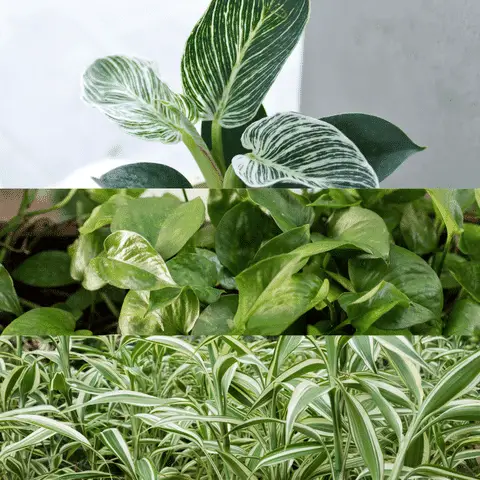
Conclusion
The spider plant is amongst the easiest and most beautiful plants to grow, portraying gorgeous long, slender green and white foliage.
However, inadequate care can stunt the spider plant’s growth. At the same time, a bit of TLC and proper care will boost the spider plant’s growth and promote vigorous, bushy growth. Lastly, propagating the spider plant and adding the spiderettes to the same pot will create a bushier effect.
Some of the links above are affiliate links, meaning at no additional cost to you, I will earn a commission if you click through and make a purchase.
